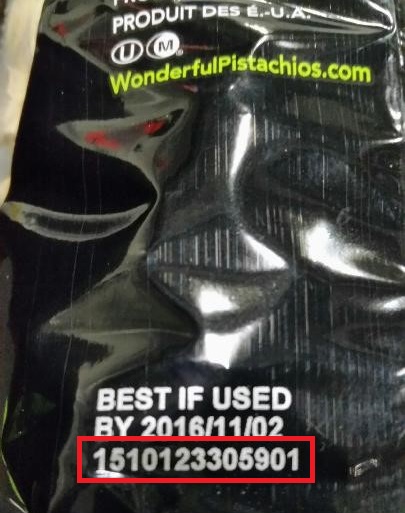2016 Salmonella Outbreak Linked to Wonderful Pistachios
Posted May 20, 2016 1:15 PM ET
This outbreak investigation is over. However, the recalled products have a long shelf life and may still be in people’s homes. Consumers unaware of the recall could continue to eat the products and potentially get sick. Read the Recall and Advice to Consumers and Retailers.
- This outbreak investigation is over. However, the recalled pistachios produced by Wonderful Pistachios have a long shelf life and may still be in people’s homes. Consumers unaware of the recalls could continue to eat the products and get sick.
- Consumers should not eat and retailers should not sell the recalled products.
- The pistachios were sold under the brand names Wonderful, Paramount Farms, and Trader Joe’s, and were sold nationwide and in Canada, Mexico, and Peru. A table of the recalled products is available on the Advice to Consumers page.
- CDC, multiple states, and the U.S. Food and Drug Administration (FDA) investigated an outbreak of Salmonella Montevideo and Salmonella Senftenberg infections.
- A total of 11 people infected with the outbreak strains of Salmonella were reported from nine states.
- Two ill people were hospitalized, and no deaths were reported.
- Collaborative investigative efforts of state, local, and federal public health and regulatory officials indicated that pistachios produced by Wonderful Pistachios were a likely source of this outbreak.
- As a result of this investigation, Wonderful Pistachios of Lost Hills, California voluntarily recalled a limited number of flavors and sizes of in-shell and shelled pistachios on March 9, 2016.
Introduction
CDC collaborated with public health officials in many states and with the U.S. Food and Drug Administration (FDA) to investigate a multistate outbreak of Salmonella Montevideo infections. Since the initial announcement on March 10, 2016, infections with an additional serotype, Salmonella Senftenberg, were included in this investigation.
Public health investigators used the PulseNet system to identify illnesses that may be part of this outbreak. PulseNet, coordinated by CDC, is the national subtyping network of public health and food regulatory agency laboratories. PulseNet performs DNA fingerprinting on Salmonella bacteria isolated from ill people by using techniques called pulsed-field gel electrophoresis (PFGE) and whole genome sequencing (WGS). CDC PulseNet manages a national database of these DNA fingerprints to identify possible outbreaks.
A total of 11 people infected with the outbreak strains of Salmonella Montevideo (9) or Salmonella Senftenberg (2) were reported from nine states. A list of the states and the number of cases in each can be found on the Case Count Map page.
Among people for whom information was available, illnesses started on dates ranging from January 3, 2016 to March 25, 2016. Ill people ranged in age from 27 years to 69, with a median age of 41. Sixty-four percent of ill people were male. Among eight ill people with available information, two reported being hospitalized. No deaths were reported.
This outbreak can be illustrated with a chart showing the number of people who became ill each day. This chart is called an epidemic curve or epi curve.
Investigation of the Outbreak
Epidemiologic and laboratory evidence indicated that pistachios produced by Wonderful Pistachios of Lost Hills, California were a likely source of this outbreak.
State and local public health officials interviewed ill people to obtain information about foods they might have eaten and other exposures in the week before they became ill. Of the 10 ill people who were interviewed, 8 (80%) reported eating pistachios in the week before illness started. This proportion was significantly higher than results from a survey of healthy people in which 12% reported eating pistachios in the week before they were interviewed. When asked about the brand of pistachios eaten, five (63%) of eight ill people reported eating Wonderful brand pistachios.
Recent laboratory testing isolated the outbreak strains of Salmonella Montevideo and Salmonella Senftenberg from samples of raw pistachios collected from Paramount Farms, where Wonderful brand pistachios are grown.
Investigators used whole genome sequencing (WGS) to get more information about the DNA fingerprint of the outbreak strains of Salmonella Montevideo and Salmonella Senftenberg causing illness. WGS showed that isolates of Salmonella Montevideo from ill people were closely related genetically. In addition, WGS showed that Salmonella Montevideo isolates from raw pistachios collected from Paramount Farms were also closely related genetically to isolates from 9 ill people. This close genetic relationship provided additional evidence that people became ill from consuming pistachios produced by Wonderful Pistachios.
On March 9, 2016, Wonderful Pistachios voluntarily recalled a limited number of flavors and sizes of in-shell and shelled pistachios because they may have been contaminated with Salmonella. The pistachios were sold under the brand names Wonderful, Paramount Farms, and Trader Joe’s and were sold nationwide and in Canada, Mexico, and Peru.
Since the announcement on March 10, 2016, new WGS results showed that isolates of Salmonella Senftenberg from two ill people were closely related genetically. WGS also showed that all 11 infections from both outbreak strains were closely related genetically to the Salmonella Montevideo and Salmonella Senftenberg isolates found in samples of raw pistachios from Paramount Farms, as well as Salmonella Senftenberg isolates found during an FDA inspection of Paramount Farms. Paramount Farms voluntarily closed the area of its production facility where the outbreak strains of Salmonella were found.
This outbreak investigation is over. However, the recalled products have a long shelf life and may still be in people’s homes. Consumers unaware of the recall could continue to eat the products and potentially get sick. Read the Recall and Advice to Consumers and Retailers.


